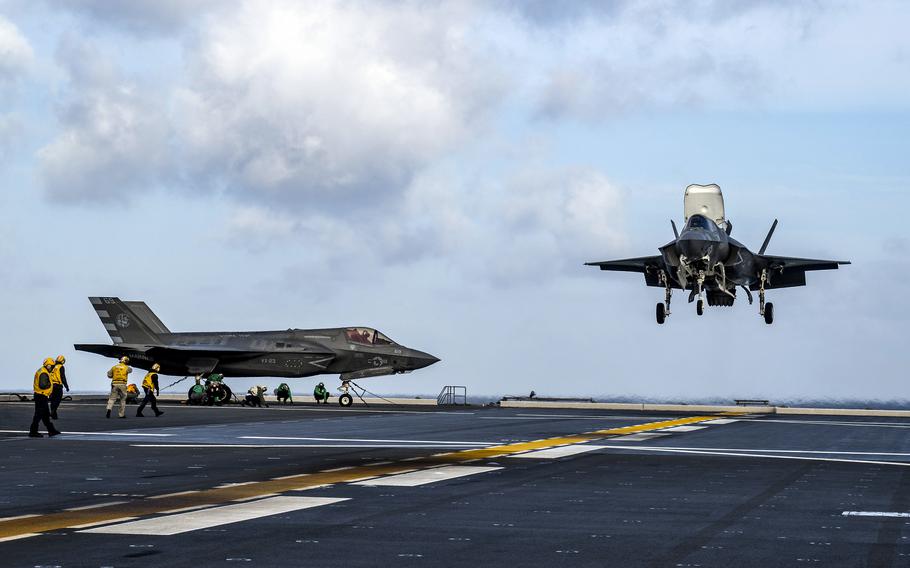
An F-35B Lightning II lands vertically aboard the Japan Maritime Self-Defense Force destroyer JS Kaga in the eastern Pacific Ocean, Nov. 2, 2024. (Darin Russell/U.S. Navy)
Japan will deploy its first F-35B Lightning II stealth fighters in the southern part of the country next month, part of efforts to bolster defenses in the Nansei Islands, according to the Ministry of Defense.
Four of the short-takeoff, vertical-landing aircraft will arrive Aug. 7 at the Japan Air Self-Defense Force’s Nyutabaru Air Base in Miyazaki prefecture on Kyushu, Japan’s southernmost main island, according to a schedule released Friday by the ministry.
The Nansei islands, also known as the Ryukyus, stretch from Kyushu to within 70 miles of Taiwan. They form a key link in the so-called first island chain, a strategic barrier for China’s navy in the event of a conflict.
The F-35Bs will be flown from the United States by U.S. pilots, a spokesman with Japan’s Air Staff said by phone Monday, without providing additional details.
A public demonstration of the fifth-generation, multirole aircraft by U.S. pilots is scheduled for sometime in September.
“Through this demonstration, residents will be able to actually experience the characteristics of the F-35B, such as noise,” the ministry said in the schedule.
Miyazaki Gov. Shunji Kono expressed concerns about the aircraft’s projected arrival to reporters after a meeting Friday with Kyushu Defense Bureau director Yasuo Ebara, a spokesman with the prefecture’s disaster prevention division said by phone Monday.
“It is regrettable that the F-35Bs will be deployed without concrete measures to reduce the burden on residents,” Kono said, according to the spokesman.
Japan announced plans in December 2018 to acquire 42 F-35Bs and in July 2020 added 63 F-35A models for a total package worth $23 billion. It has also upgraded two flattop warships designed for helicopters — the JS Izumo and JS Kaga — to accommodate the aircraft, including hardening their decks to withstand Lightning II engine heat.
“It is extremely important to establish a flexible operational system that enables air superiority to be secured from as many airfields as possible using high-performance fighter aircraft,” the ministry said in a March 24 news release.
All the aircraft will eventually be based at Nyutabaru, the spokesman said. He declined to say if Japan’s F-35Bs would work alongside Marine Corps counterparts. Some Japanese government officials speak to the press only on condition of anonymity.
Marine Corps Air Station Iwakuni, about 150 miles north of Nyutabaru, is home to two permanently stationed F-35B squadrons and two squadrons there temporarily under the Unit Deployment Program.
Japan plans to equip its Izumo-class warships with the F-35Bs during contingencies, exercises and disaster responses, according to the fiscal 2022 ministry white paper. The Kaga completed F-35B trials off Southern California on Nov. 6, a Maritime Self-Defense Force spokesman told Stars and Stripes at the time.
Another four F-35Bs are expected at Nyutabaru by March 31, the end of Japan’s fiscal year, according to the schedule.
The Air Self-Defense Force established two units of F-35B personnel at the base in March in preparation for the aircraft’s arrival, according to Japan’s fiscal 2025 ministry white paper.
Following the September demonstration, the aircraft crews will train on vertical landings at Nyutabaru. Japan originally planned this training at a new air base under construction on Mageshima, a small volcanic island in Kagoshima prefecture, but construction delays led the ministry to reconsider, according to the March news release.